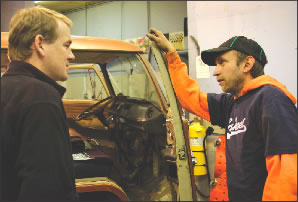by John Mattingly
We’re in a global crisis: Economic, ecologic, psychologic.
Many fingers are being pointed and wagged.
But I have yet to hear anyone point out that, just possibly, the root of the crisis is a species behaving badly. And yes, I’m referring to the human species, homo sapiens sapiens. That means you, that means me.
All other species on Earth behave in ways that are very different from humans. Some of this deviation is to be expected, as humans are a unique species, but compared to highly successful species (success defined in terms of longevity, as without persistence, all other features of success remain unexpressed) humans have a few key things to learn.
1. The population of successful species is always determined by food supply, which in turn is determined by the amount of productive, species-specific solar energy received in a given year. In years when the sun is generous, populations expand; the reverse is true in lean years.
Humans circumvented this annual solar limitation with the invention of farming. Initially, this was well rooted in annual solar energy, and represented an ingenious amplification of that energy through seed and plant selection, waste incorporation for fertilizer, and modest irrigation.
However, when farming began to use oil, natural gas, mined fertilizers, big machinery, and finally massive credit structures, humans began to behave badly, borrowing from the future to extract stored solar energy from the past to create an illusory cornucopia in the present.
2. Successful species create waste, both metabolic (dung) and cultural (by-products of habitat alterations), but in a great majority of cases, the waste products of successful species integrate easily into their immediate food web, or at the very least are not toxic to themselves or to their neighboring species. Typically, the dung of one species creates fertility in the food web of several other species, and/or the habitat alterations of one species creates a niche for another.
Humans ignore the basics of commensul behavior among species by creating huge amounts of waste, much of which is not only toxic to humans (auto-toxic), but toxic to other species. Humans have thus taken “fouling one’s nest” to a planetary scale, and no species has ever been successful if it created auto-toxic waste products.
3. As a primary strategy for adaptation and survival, successful species usually alter their physiology before altering their habitat or niche, as the latter option requires enormous amounts of energy. Physiological alterations simply take time, and initially humans applied this approach. Those colonizing at higher elevations evolved bigger lungs with capacity for more red blood cells, those in cold climates evolved fat layers for insulation, those near the equator evolved darker skin, and so forth.
Only when humans started to figure out how to tap into stored solar energy did they begin behaving badly. Initially, they burned wood, peat, coal, and whale oil, causing relatively minor disturbances to the planet, but this ultimately created an appetite for more stored solar energy that led to the discovery of oil and natural gas, fueling a strategy for adaptation based on making monumental alterations to the planetary habitat: dams, roads and bridges, climate controlled structures, concentrated housing systems, and mono-cultural farming.
It isn’t just that our world economy and environment are in crisis. Our species is in trouble, and the “crisis” is, beyond all the mounting details expressed in the press, an indicator of ultimate jeopardy. On that cheery note, it should be mentioned that 99% of all species that once lived on Earth are now fossils. Which gives us some perspective on our “dominion” and place in the Great Scheme Of Things. Oh, and the most successful species of all, such as cyanobacteria, who have 4+ billion years under their belt, don’t have a brain, nor do most species that have been around for about a billion years. Brains take a lot of energy, support, and redundancy, so most species haven’t seen brains as a worthwhile investment. And many of the current long-lived species on Earth are ocean dwellers.
But humans can’t do much about being land-based, energy-hungry, brain-bearing mammals. And I’m not a confirmed pessimist with a laundry list of complaints and no solutions, nor am I a big fan of returning to our pastoral heritage in the cave.
For homo sapiens sapiens, there are only three types of escapes from the fossil bed.
1. Cataclysm that reduces the human population to a sustainable level at which our annual consumption of solar energy equals the annual solar dividend. This is actually a popular solution among many apocalyptic groups who have been predicting the end of humanity for the last 2000 years. I don’t favor this gruesome solution, even though it may be inescapable.
2. Accommodation to the planet, through sensible changes to sources of energy and power that meet the needs of our civilization in such way that we use only annual solar energy and gradually reduce our impact on other species, as well as on the planet. The current administration in the U.S. is talking this line, but facing numerous brick walls of vested interests. And, of course, these changes will happen more slowly than its advocates would like. But, if humans can muddle through a few more centuries while doing mostly the right things, there is hope.
The biggest problem will be with the food supply. We simply cannot feed everyone on the planet now without tapping into stored solar energy. To be more precise, we could feed everyone, but not in the way and style to which we have become accustomed. Nine billion humans can be fed without tapping into stored solar energy if they eat meat rarely, lots of nuts, whole grains, algae and bark. A far cry from the variety offered in Whole Foods, or even your local Safeway.
3. Change form. I call this the Doom and Bloom solution. We are, as far as we know, the only species to figure out that everything is finite. The Earth, our solar system, our sun, our galaxy, even our universe, will end. Most of these terminations are a long way off, except for the Earth, which has a history of being very inhospitable to mammals, and thus humans, on a regular basis.
The last 5,000 years on Earth have been ideal for mammals, and there’s no way of knowing if these ideal conditions will persist for another 5,000 years, or even another 5 months. An asteroid just missed Earth last month by a mere 40,000 miles. From the perspective of the universe, this was like having our eyeglasses knocked off our nose by a wrecking ball without leaving so much as a scratch on our face. Volcanos can go off at any time to give the Earth consecutive years of winter, while earthquakes, tsunamis, and hurricanes wreak localized damages. And there is the possibility of radical climate changes on the horizon that will make life on Earth very unpleasant for all land-based brain-bearing mammals.
Bill Bryson, in his book, A Brief History of Nearly Everything, pointed out that in the long view, Earth has been a very dangerous place. Challenges to the survival strategies of all species come along with documented and alarming regularity. Humans have been living in a period of especially favorable conditions for most of the last 250 years, during which time our population expanded exponentially while we developed a bomb that could obliterate all life on Earth—–a curious irony.
If humans would only look to other, successful species for a good survival strategy on this peril-ridden planet, they would see that changing our physiology rather than our habitat is absolutely the best way to go. Few would argue that the most unique aspect of the human species is our consciousness, but there is no reason why that consciousness must be contained and energized inside a global bone atop the body of a non-commensal, energy-eating, land-based, brain-bearing, nest-fouling mammal.
Next month I will explain.
John Mattingly cultivates prose, among other things, and was most recently seen near Creede.

